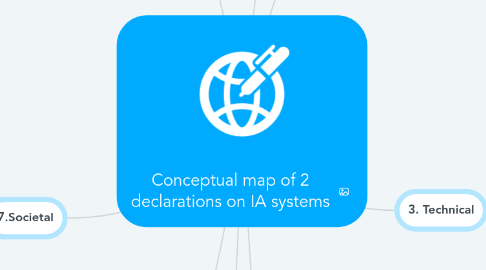Conceptual map of 2 declarations on IA systems
by Albert Ribera

1. 6. Economic
1.1. Need of specify in a human-way the border between that tasks are done by a AI system or by a human people process. So every person, should be advise that is an AI mechanism.
1.2. Ensure that the economic consequences of Automated Decision Making adoption are fully considered.
2. 5. Legal
2.1. IA certification rules needed to accomplish the quality criteriums for a good and ethic implementation of AI systems.
2.2. Define clear legal responsibilities for ADM’s use and impacts. The core principles currently governing Automated Decision Making development within the computing professions—accountability, traceability, and responsibility—should be adopted as the basis for broad discussion and debate among legal and technical experts, the media and society at large in pursuit of new legal norms to govern wide-scale Automated Decision Making deployment.
3. 7.Societal
3.1. Need of legal rules and laws to ensure that developers are conscious that some systems have the responsibility of human lifes.
3.2. Mandate that all privacy and data acquisition practices of Automated Decision Making deployers be clearly disclosed to all users of such systems. Data is the fuel for machine learning. Where and whenever information is collected, what is being collected and the uses to which it will be put should be described to the data provider concisely and clearly.
3.3. Increase public funding for non-commercial Automated Decision Making-related research significantly. Additional research is necessary to better understand machine learning and its use in systems to influence human behaviour. Many fundamental issues remain to be investigated. Robust public knowledge of these techniques, without depending predominantly upon industry for research results, is a prerequisite for a broader debate about their acceptability
4. 8.Educational
4.1. Need of cooperation between human and AI systems to benefit one of other.
4.2. Foster ADM-related technical education at the University level. All university students should receive instruction in the practicalities and potential of machine learning. Students of all disciplines need to be aware of the impact this technology will have on their field and future work.
4.3. Complement technical education with comparable social education. Because of the increasing impact that technology will have on society, technical curricula also should educate students to deal with complex scenarios by complementing technical skills with the development of critical thinking, digital wisdom, and ethical judgement.
4.4. Expand the public’s awareness and understanding of ADM and its impacts. There is a clear need to educate the general public in this technology, as it is being rapidly introduced and will affect virtually everyone in their professional and private lives.
5. 1. Tool Justification
5.1. MindMeister is an online mind mapping tool that facilitates collaborative brainstorming, planning and note taking. Whether you need to capture the essence of a feature or map out an entire project plan on a single page, everything is quick and painless.
5.2. MindMeister offers powerful features to style mind maps.
5.3. MindMeister is a knowledge-based mind mapping tool that we can use to understand and make connections between concepts, ideas, and information
6. 2. Introduction
6.1. “AI algorithms, particularly those embedded in the web and social media, are having an important impact on who talks to whom, how information is selected and presented, and how facts (justified or fake) propagate and compete in public space.”
6.2. “The use of AI in decisions on parole has caused an outcry because the basis of these decisions is obscure due to the black box nature of deep learning and biased in ways that are unacceptable”
6.3. The Barcelona Declaration for the Proper Development and Usage of Artificial Intelligence in Europe
6.4. When Computers Decide: European Recommendations on Machine-Learned Automated Decision Making
7. 3. Technical
7.1. Need of specify what is IA and what it is not. A wide definition can lead to problems on how to develop ethic and legal solutions to human problems.
7.2. Europe is made of a wide range of cultures and languages, and EU should take into account that but develop a concrete roadmap in common.
7.3. IA needs to arrive through every region and economy.
7.4. Establish means, measures and standards to assure that Automated Decision Making systems are fair: All key actors (including academia, industry, government institutions, international institutions, NGOs, and citizens) must be involved in the formulation of standards and practices that ensure that the public good is the primary criterion for assessing Automated Decision Making quality.
8. 4. Ethical
8.1. Focuses on the need of the limits of IA can do, and how to share it so every citizen has to be conscious about it.
8.2. Ensure that Ethics remain at the forefront of, and integral to, Automated Decision Making development and deployment: member countries as well as the European Union should develop ethics committees to advise the societal, political, academic, and legal systems about the positive as well as negative consequences of Automated Decision Making initiatives, tools, and systems.
8.3. Promote value-sensitive Automated Decision Making design. Stress that social values and the ethical priorities of technology users must be designed into all aspects and elements of Automated Decision Making.


